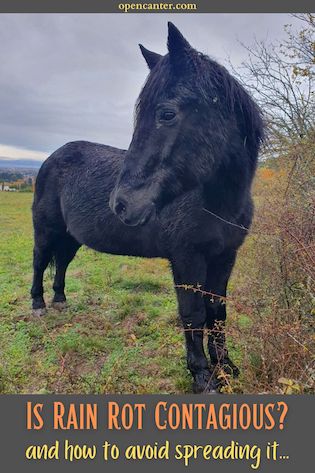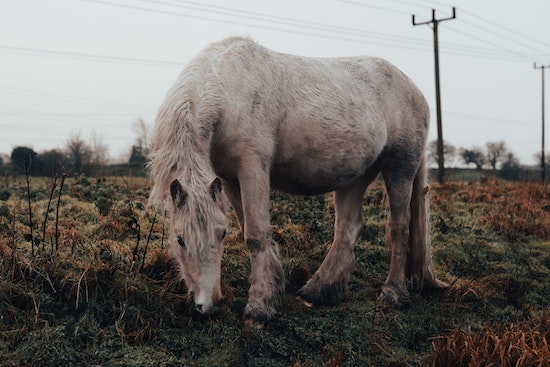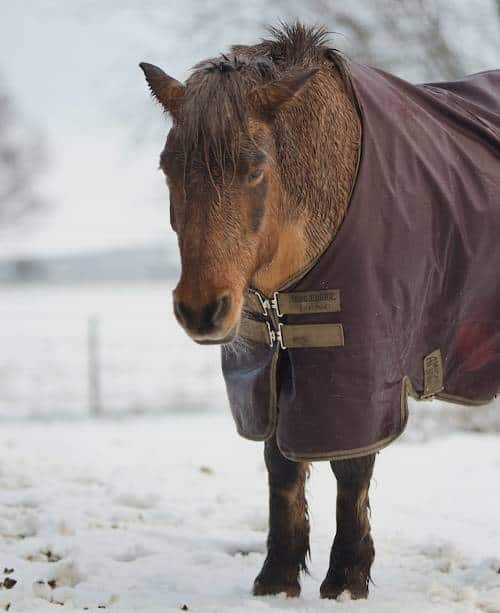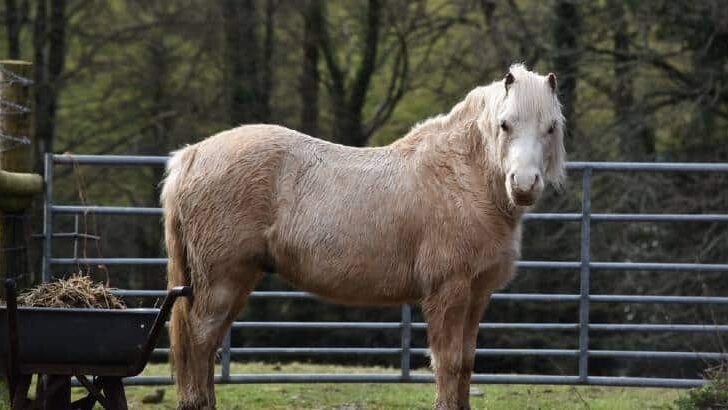Affiliate Disclaimer
As an Amazon Associate I earn from qualifying purchases. It helps me keep the website going. Thank you for your support.
If you have noticed that your horse has a skin condition, it’s best to get the vet to check it over. Skin conditions in horses can often be overdiagnosed as rain rot. But if the vet has confirmed that your horse has rain rot, what does this mean? How should you handle the situation and is rain rot contagious?
Unfortunately, yes – rain rot can be contagious. It’s a condition that’s seen in many animals, and can even be transmitted to humans. Rain rot is also known as Rain Scald and Contact Dermatitis.
Here, we’ll take a closer look at rain rot in horses, including how to treat it and how to prevent it in the first place.

What Exactly is Rain Rot?
Rain rot is caused by the bacteria Dermatophilus Congolenis. This organism usually lives naturally on horses’ skin, often in large quantities without causing a problem. However, if the skin becomes broken, the bacteria can invade and multiply quickly, causing the condition known as rain rot.
Causes
- Prolonged and repeated exposure to rain – when the skin is damp it’s more likely to crack or tear.
- Insect bites – again, this breaks the skin and allows access to bacteria.
- Sunburn – dry and burnt skin will crack more easily.
- Poor immune system – the horse’s natural ability to defend itself is weakened.
- Wounds/cuts – allows easy entry for the bacteria to invade and multiply.
- Secondary infection from Mud Fever.
Symptoms
- Early on in the disease, small pustules form that are usually unnoticed until the secretions start to trap dirt and hair. The hair then sticks up, giving the characteristic paintbrush effect.
- When the coat is brushed or rubbed, the hair falls out leaving smooth skin underneath.
- As the condition worsens, hair loss can be quite dramatic. Large bald patches appear, giving a general moth-eaten appearance.
- Small scabs and sores occur, usually along the sides and back. Sometimes they can even develop on the nose and mouth. In more severe cases, there can be bleeding and secondary infection from different bacteria.
- Your horse may also be scratching more than normal, or showing signs of pain and discomfort.

Are Some Horses Especially Susceptible to Rain Rot?
Yes, any horse with a weakened immune system can be more vulnerable to rain rot, for example, those with Pituitary Pars Intermedia Dysfunction (PPID). A horse with pre-existing lesions is more susceptible. And horses without shelter are at risk too, as they never have the chance to dry out.
Why is Rain Rot Contagious?
- Debris – The bacteria can be found in the scabs and hair that fall off an infected horse. As a result, any other horse that encounters the scabs and hair is at risk of developing rain rot.
- Grooming – Using the same grooming equipment between infected horses and non-infected horses can cause an infection to spread quickly.
Horses like to groom each other by biting and nibbling. Normally this is quite gentle, but occasionally if it becomes vigorous, breaks in the skin can occur and infection can develop. - Parasitic transmission – Bacteria can be transmitted between horses by parasites such as ticks or fleas. If a horse is bitten by a parasite, there will be a tiny lesion in the skin. This provides an entry point in the horse’s skin for bacteria. The bacteria may already be present on the horse’s skin, or it might be introduced by a transmitting parasite.
Diagnosing Rain Rot
The scabs and sores have a fairly characteristic appearance and are usually seen on a horse’s back and sides. The paintbrush look, where the hair sticks up in clumps is also fairly unique to this infection.
If you’re at all unsure, arrange for your vet to see the horse, they’re often confident to diagnose rain rot just by observation. Failing that, a skin sample can be sent to a lab for further analysis, and to rule out other infections.
Treatment
In mild cases, cleaning with a diluted solution of Chlorhexidine such as Hibiscrub should be enough to clear the infection. Wash your horse daily, until the lesions have disappeared. Separate him from others if possible and clean all tack and grooming equipment thoroughly.
If this doesn’t help or it’s a more severe infection causing pain and bleeding, please contact your vet. They may well need to prescribe antibiotics to clear the infection. Only ride or work your horse lightly, and even then, only if the infection is mild. If your horse has lesions along its back or the infection is severe, riding is not an option.
Some Complications of Rain Rot
- Mud fever – this is in fact caused by the same bacteria that causes rain rot. Characterized by sore heels/pasterns with a red inflamed appearance. You can read more about mud fever here.
- Secondary infection from other bacteria, such as Staphylococcal Folliculitis. This most often occurs following previous skin trauma and disease. In the early stages, the hair also stands up, with bald patches developing as it progresses. It may be worth your vet taking samples to check for this if your horse isn’t responding to rain rot treatment.
- Emaciation – painful areas on the nose and mouth can stop a horse from eating and drinking.
- Colic – dehydration can cause the gut to slow down.
- Death in severe cases that are left untreated.

How to Prevent Rain Rot
- Remove any rugs and groom daily – running your hand along your horse’s flank and back is useful, as often you can feel early lumps in the skin that aren’t easily seen.
- Store your saddle upside down, as this will allow it to dry out more thoroughly after use.
- Don’t let your horse stay wet for long periods of time.
- Use fly sheets or repellents to prevent the skin from being broken by insects.
- Allow your horse regular turnout, especially in sunny weather as this helps to dry out the skin. Do make sure the horse doesn’t suffer from sunburn though, as this will destroy the skin barrier.
- Consider using plants around the stable area to keep insects away. Scented Geraniums, Lavender and Garlic can be really effective.
- Feed your horse an immune-boosting diet.
- Try and keep your horse’s stress levels to a minimum, as this can weaken the immune system.
Final Thoughts
If you think your horse has rain rot – don’t panic!
Although rain rot is contagious it is very treatable, even severe cases have good outcomes with careful management and advice from your vet.
And please, just remember, this can happen to any horse and is not necessarily related to bad management or neglect!




